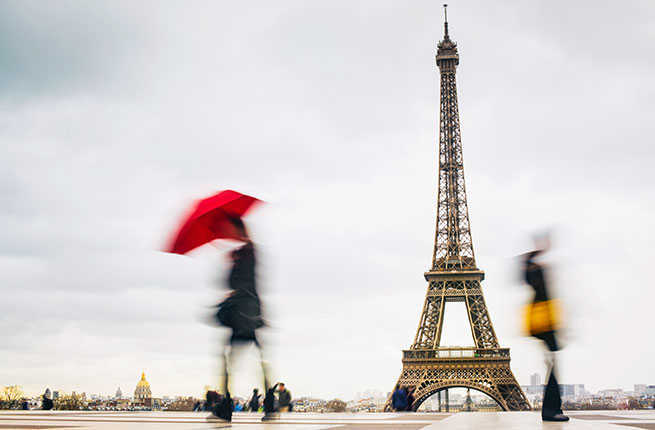
There’s no better way to explore a city than wandering its streets and alleys, from terracotta-hued palaces, picturesque squares, and baroque architectural showstoppers in Rome, to the modern glass towers, 19th-century limestone mansions, and secret, pocket-size parks of Manhattan. We’ve gathered 10 fabulous walks in our favorite cities in the United States and Europe, so put on your comfy shoes and hit the streets.
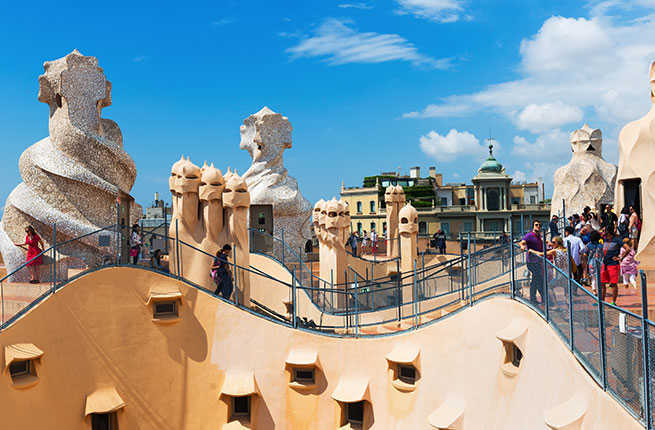
Barcelona
EIXAMPLE’S ART NOUVEAU
START: Plaça de Catalunya
END: Hospital de Sant Pau
TIMING: All day with a tour of Temple Expiatori de la Sagrada Família
The Eixample district is packed with Barcelona’s best architectural examples of the Catalan Art Nouveau. Starting in the Plaça de Catalunya, walk up Passeig de Gràcia until you reach the corner of Consell de Cent. Here is the Manzana de la Discòrdia (the Block of Discord), where the three great figures of Barcelona’s late-19th-century Moderniste movement—Lluis Domènech i Montaner, Josep Puig i Cadafalch, and Antoni Gaudí—went head to head with three radically different buildings: Casa Lleó Morera, Casa Amatller, and Casa Batlló. The Casa Montaner i Simó— Fundació Tàpies, with its wire sculpture Núvol i cadira (Cloud and Chair) by Antoni Tàpies, is just west, around the corner on Carrer d’Aragó. Swing by Casa Domènech i Estapà on Carrer de Valencia for a more conservative take on the Art Nouveau movement. Gaudí’s Casa Milà was controversial thanks to the undulating stone façade and twisted iron balconies. Do take time to see the roof, the Gaudí museum, and the early-20th-century apartment. Just around the corner, on Avinguda Diagonal, is Puig i Cadafalch’s Palau Baró de Quadras; it’s just two minutes from the architect’s Nordic castle fantasy, the Casa de les Punxes. From here it’s only a 10-minute stroll to Passeig de Sant Joan and yet another Puig i Cadafalch masterpiece, Casa Macaya. By this time you’re only three blocks from Gaudí’s Temple Expiatori de la Sagrada Família (set aside half the day for this masterpiece). Finish off the tour with a stroll over to Domènech i Montaner’s Hospital de Sant Pau, another Moderniste monument and a World Heritage Site. Tours are offered in English daily.
PLAN YOUR TRIP: Visit Fodor’s Barcelona Guide
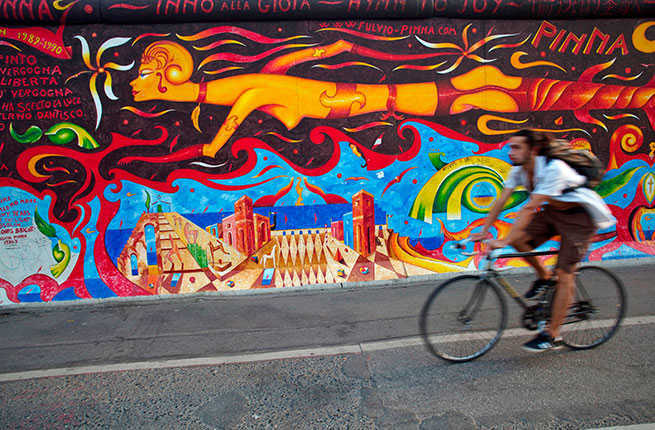
Berlin
CITY CENTER BERLIN WALL TRAIL
START: Potsdamer Platz
END: Mühlenstrasse
TIMING: Half a day
A cobblestone path traces the course of the former border between East and West Berlin and illuminates the effects the Wall had on the city: it cut through streets, neighborhoods, and even buildings. Start at Potsdamer Platz, the heart of New Berlin, where the two halves of the formerly divided city have grown together and where a tiny stretch of the Berlin Wall still stands. Walk south along Stresemanstrasse from Potsdamer Platz, and then head east along Niederkirchnerstrasse two blocks to the Checkpoint Charlie Museum. Continue east to the modest column engraved “He only wanted freedom,” in German, at Zimmerstrasse 15, commemorating Peter Fechter, an 18-year-old who was shot and killed while trying to escape to the West. Next wander to Engelbecken Pond and take in the views. Keep walking along Bethaniendamm and you’ll come to a colorful ramshackle wooden structure. This is where a Turkish immigrant named Osman Kalin planted vegetables in the shadow of the Wall. Little did he know that this piece of land actually belonged to East Berlin but the Wall had missed it. His family still grows onions and cabbages on the plot. Even the most bizarre circumstances were normal in Cold War Berlin—and some of these oddities have survived the change of times. End the walk by crossing the Spree River at the Schilling Bridge. Turn right to walk parallel to the river. Fast-forward on Mühlenstrasse to the famous East Side Gallery, where artists from all over the world decorated the 4,000-some-foot remaining stretch of wall with colorful murals. Unfortunately, a section was demolished to construct a riverside condo, and the future of this iconic piece of the wall remains unclear.
PLAN YOUR TRIP: Visit Fodor’s Berlin Guide

Chicago
DOWNTOWN SKYLINE
START: Wacker Dr. and Adams St.
END: 100 W. Randolph St.
TIMING: 2 to 4 hours, depending on stops
The Great Fire of 1871 could have been the death of Chicago, but instead it proved to be a grand rebirth, as renowned architects rebuilt the city’s skyline. Today it’s Chicago’s most awe-inspiring attribute. Start with the Willis Tower, a 1,454-foot giant that was the world’s tallest building when completed in 1973. Next, head to South LaSalle St. and the Rookery Building. This 12-story stunner, completed in 1888 by Daniel Burnham and John Welborn Root, is the oldest standing high-rise in town. On Jackson, check out the 45-story Art Deco Chicago Board of Trade, designed by Holabird and Root in 1930. Also on Jackson Blvd. is Burnham and Root’s 17-story Monadnock Building. Built in 1891, it’s the last and tallest skyscraper built with masonry load-bearing walls. The nearby 224 S. Michigan Ave. was also built by Burnham in 1904. On Congress Parkway see Louis Sullivan and Dankmar Adler’s Auditorium Theatre, a grand theater completed in 1889 that still hosts performances. Double back to Jackson and Dearborn to see the geometric, 4.6-acre Federal Center, completed in the early 1970s by Mies van der Rohe. Don’t miss the graceful slopes of Chase Tower, built in 1969 as the First National Bank of Chicago Building. The Sullivan Center, at State and Madison streets, has elaborate cast-iron ornamentation over its entryway and a vertical, three-part “Chicago Window.” The Reliance Building (now the Hotel Burnham) on State St. is the first-ever glass-and-steel skyscraper. On the northeast corner of State and Washington is Macy’s, designed by Burnham in 1907 and most famous for the multistory atriums inside, one domed with a Tiffany mosaic. Finally, walk west on Randolph St. to reach the 648-foot Richard J. Daley Center at Clark St. Across Randolph is Helmut Jahn’s dome-shape James R. Thompson Center.
PLAN YOUR TRIP: Visit Fodor’s Chicago Guide

London
WESTMINSTER’S ROYAL HERITAGE
START: Westminster Abbey
END: Houses of Parliament
TIMING: A full day of exploring
This regal runaround packs more into a day than most cities can offer in a week. Hit Westminster Abbey early to avoid the crowds, then cut through St. James’s Park to catch the Changing of the Guard at 11:30 am at Buckingham Palace. (If the palace doors are open, enjoy a peek at royal life.) Take a quick detour to the Tudor delights of St. James’s Palace, old haunt of Charles I, before a promenade down the Mall past the Regency glory of Carlton House Terrace and through Admiralty Arch to Trafalgar Square. This is the official center of London, dominated by the 170-foot Nelson’s Column and its enormous bronze lions. The lampposts on the south side, heading down Whitehall, are topped with ships—they all face Portsmouth, home of the British navy. Check out the statue of George Washington, a gift from the state of Virginia in 1921, on the lawn at the north side by the National Gallery. At the southern point of the square is a statue of Charles I on a horse. Charles II had it placed here in 1667, near the spot where his father was executed in 1649. After lunch, choose from the canvases of the National Gallery (there are more than 2,300 works, from Michelangelo, Leonardo, Turner, Monet, van Gogh, Picasso, and more). Or check out who’s who at the National Portrait Gallery. If your energy is starting to flag, head over to the crypt of St. Martin-in-the-Fields for a little brass rubbing; it’s a fun way to create your own keepsake. Finish with a stately stroll down Whitehall—past Downing St., Horse Guards Parade, and Banqueting House—to the Houses of Parliament, where you have the option of pre-booking a tour or trying to get in to see a debate.
PLAN YOUR TRIP: Visit Fodor’s London Guide
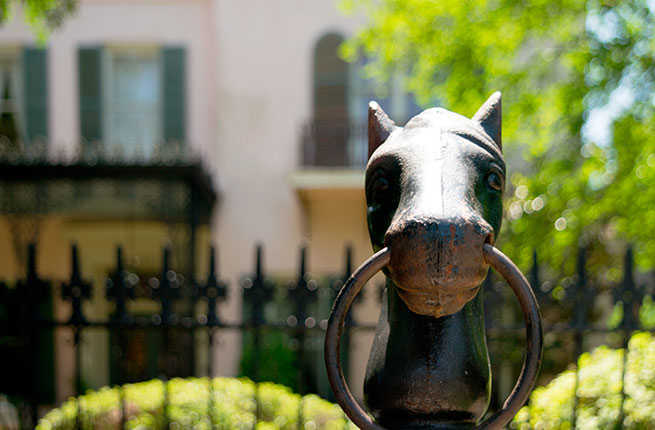
New Orleans
GARDEN DISTRICT HOUSES
START: Washington Ave. and Prytania St.
END: 1416-1498 Washington Ave.
TIMING: 45 minutes (without stops inside)
A walk through the Garden District, just a 20-minute streetcar ride from the French Quarter, provides a unique look at life in New Orleans, past and present. Start at The Rink, a small shopping complex, and walk east on Prytania to see Colonel Short’s Villa with its ornate cornstalk fence. The Briggs-Staub House is one of the few Gothic Revival houses in the city. The Lonsdale House was a Catholic chapel for more than 70 years. The Maddox House is an example of the five-bay Greek Revival expansion. The Women’s Guild of the New Orleans Opera Association House has a distinctive octagonal turret. The Bradish-Johnson House is regal, while the relatively modest raised Toby Westfeldt House is an example of a Creole colonial home. Morris House and the Carroll House are decorated with “iron lace,” exemplifying the romantic Italianate style. Brevard House has an ornate cast-iron gate that extends the length of the block. A block farther on the right is the Payne House, where Confederate president Jefferson Davis died. Actor John Goodman lives in the Italianate Mansion at 2425 Coliseum St. The white-columned Robinson House was the first house in New Orleans with indoor plumbing. Check out the intricate ironwork at Musson House. The white-columned Nolan House is where the film The Curious Case of Benjamin Button was set. The Commander’s Palace is a great stop for lunch. End the tour with a visit to the white-walled Lafayette Cemetery No. 1, arguably the most beautiful cemetery in New Orleans.
PLAN YOUR TRIP: Visit Fodor’s New Orleans Guide
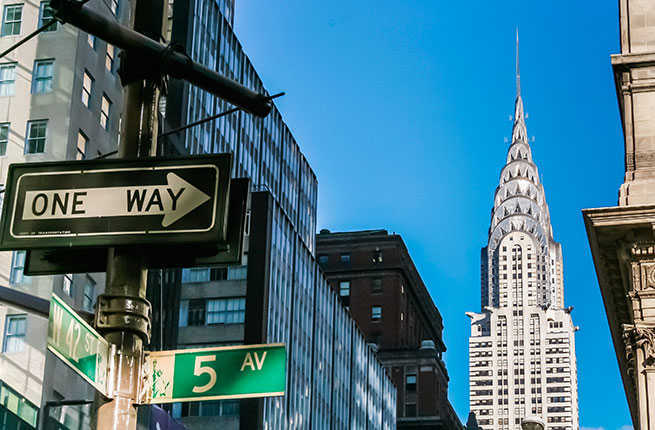
New York City
MIDTOWN ARCHITECTURE
START: 5th Ave. at 42nd St.
END: 45 Rockefeller Plaza
TIMING: 1½ to 2 hours
Midtown is a mind-boggling patchwork of styles that coalesce into one of the world’s great urban landscapes. Begin with a taste of early 20th-century neoclassicism at the New York Public Library, and walk along East 42nd St. to the Beaux-Arts Grand Central Terminal, two brilliantly designed public spaces as beautiful as they are functional. Art Deco is perhaps Midtown’s most distinctive style, with the Chrysler Building considered one of the great masterpieces. Double back and head north on Park Ave. to check out such Jazz Age landmarks as the Waldorf-Astoria Hotel. Just past that is the Byzantine dome of St. Bartholomew’s Church and two blocks north of that is the bronze-and-glass Seagram Building, designed by modernist innovator Mies van der Rohe. Pop into the flagship Louis Vuitton—Moët Hennessy Tower, an arched glass skyscraper that’s both conspicuous and elegant. The Trump Tower’s ostentatious atrium flaunts unbridled luxury, with expensive boutiques and brass accents. When you reach 54th St., turn right. The two remaining 19th-century mansions at Nos. 9–11 and Nos. 13–15 West 54th St. are in sharp contrast to Midtown architecture. Nos. 9–11 are inspired by Colonial American architecture; note the oriel windows, heavy carvings, and sweeping, paired staircases.
Finally, head south on 6th Ave. for a landmark piece of Art Deco architecture, Radio City Music Hall, with its distinctive pink-and-blue neon sign. Loop around through Rockefeller Center, and finish by taking in the plaza there with its stark lines and the crowning statue of Prometheus.
PLAN YOUR TRIP: Visit Fodor’s New York City Guide
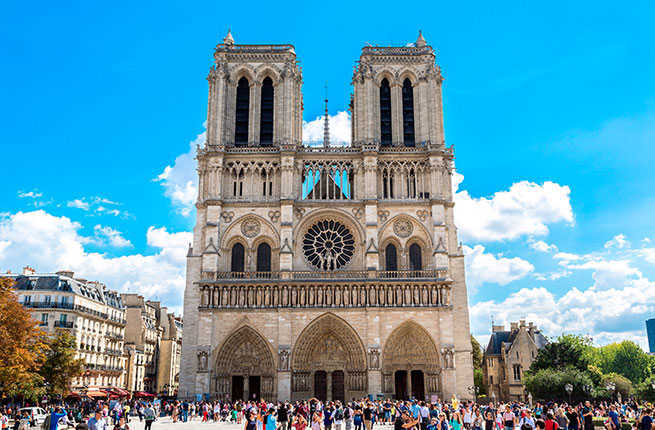
Paris
STROLL THE LEFT BANK
START: Pont Neuf
END: 49 rue Monge
TIMING: 1½ hours
Experience the counterculture and creativity of the Left Bank, along with stunning architecture, 2nd-century Gallo-Roman ruins, and the city’s oldest street. Start at the Pont Neuf for excellent views off the western tip of the Ile de la Cité, and then explore the island’s magnificent architectural heritage, including the Conciergerie, Sainte-Chapelle, and Notre-Dame. There’s much to see at this awe-inspiring cathedral, like the rose window above the main portal, which dates from the 13th century. The three windows below it contain some of France’s finest examples of 12th-century stained-glass artistry. The brave can climb the spiral staircase to the towers for a gargoyle’s-eye view of the city. Detour through neighboring Ile St-Louis and explore the boutiques, cafés, and restaurants before heading into the medieval labyrinth of the Quartier Latin. Its most valuable treasures are preserved in the Musée de Cluny, including the reconstructed ruins of 2nd-century Gallo-Roman steam baths. At the summit of the hill above the Sorbonne university is the imposing Panthéon, a monument to (and mausoleum of) French heroes. Don’t miss the exquisite Eglise St-Etienne-du-Mont next door, where the relics of the city’s patron Saint Geneviève are displayed. Follow the Rue Descartes to the Rue Mouffetard, a winding cobblestone street that is one of the city’s oldest and was once a Roman road leading south from Lutetia (the Roman name for Paris) to Italy. The upper half is dotted with restaurants and bars that cater to tourists and students; the lower half is a lively morning market Tuesday through Sunday. If the sun’s shining, finish the walk by visiting the Gallo-Roman Arènes de Lutèce, a Roman amphitheater that was almost completely destroyed by barbarians in AD 280.
PLAN YOUR TRIP: Visit Fodor’s Paris Guide
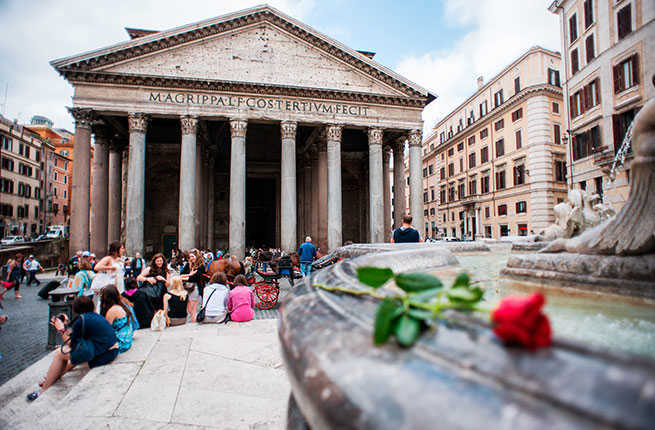
Rome
HISTORIC CHURCHES & PIAZZAS
START: Il Gesù
END: Santa Maria della Pace
TIMING: Around 1½ hours
The Navona and Campo districts are the Rome of your dreams, full of terracotta-hued palaces, picturesque squares, and one architectural showstopper after another. Begin at the super-opulent Il Gesù, the church that introduced the Baroque style to 17thcentury Rome. Head toward Piazza della Minerva and Santa Maria sopra Minerva, home to Michelangelo’s marble Risen Christ statue. The loincloth was added later, sometime during the Baroque period. Outside is another remarkable sculpture, the Elephant and Obelisk by Bernini, father of the Baroque. The Egyptian obelisk sitting atop the elephant was discovered during nearby excavations in the mid-1600s and the final work was unveiled in 1667. Straight ahead lies the Pantheon, one of the wonders of the ancient Roman world. The building’s dome remains the world’s largest unreinforced concrete dome, and the oculus, at its apex, is the only source of light besides the entrance. From Piazza della Rotonda take Via Giustiniani to San Luigi dei Francesi to see Caravaggio’s moving cycle of paintings depicting the life of Saint Matthew. These include the three most famous canvases, The Calling of Saint Matthew, The Inspiration of Saint Matthew, and The Martyrdom of Saint Matthew. Next, head to the Baroque Sant’Ivo alla Sapienza. Be sure to look up at the lantern of Sant’Ivo: a swirling spiral shape like whipped cream that is said to have been inspired by a bee’s stinger. Follow the crowds to Piazza Navona, Rome’s most celebrated 17th-century example of Baroque exuberance, with Bernini’s Fountain of the Four Rivers dead center. Either grab a caffè table and watch the world go by here, in front of 17thcentury Sant’Agnese in Agone, or head on to the enchanting Piazza della Pace, where Santa Maria della Pace sits on a tiny piazzina; the scene is one of Rome’s most attractive streetscapes.
PLAN YOUR TRIP: Visit Fodor’s Rome Guide

San Francisco
NORTH BEACH BEATNIK WALK
START: 261 Columbus Ave.
END: Corner of Grant Ave. and Green St.
TIMING: 45 minutes, depending on how long you linger
Home to American bohemia and birthplace of the Beat Movement, North Beach still crackles with the energy of the revolutionary artists who electrified a generation here in the sixties. Start at City Lights, the era’s epicenter of progressive thought and the country’s most daring publisher. Outside, neighboring Jack Kerouac Alley is inlaid with the words of Kerouac, Maya Angelou, and Confucius. At Vesuvio, an art-splashed saloon, order a drink and soak up the neighborhood’s vibe. Walk up to Broadway and take in the public art on the corner: Language of Birds is a flock of illuminated books that appear to have just taken flight. Notice the words and phrases embedded in the plaza floor that could have just fallen from the pages. The Beat Museum on Broadway is a quirky collection of photos, books, music, and artifacts. It firmly places the Beat Generation in history; their rejection of the status quo was an artistic reaction against 1950s Cold War conformism. They were deeply influential in the antiestablishment counterculture of the ‘60s as well. Head around the corner to No. 1010 Montgomery; this is where Allen Ginsberg wrote Howl. Continue up Montgomery, turn left, and walk up the Vallejo stairs and onward to the venerable Caffe Trieste, a favorite perch of Kerouac, Ginsberg, and Charles Bukowski. Head north up Grant to No. 1398, where the Co-Existence Bagel Shop (now long closed) served as the living room of the Beat Generation in the days when cops arrested kids for wearing sandals. End the walk by browsing Grant Ave.’s excellent boutiques, and pick up some edgy couture or vintage botanical prints.
PLAN YOUR TRIP: Visit Fodor’s San Francisco Guide
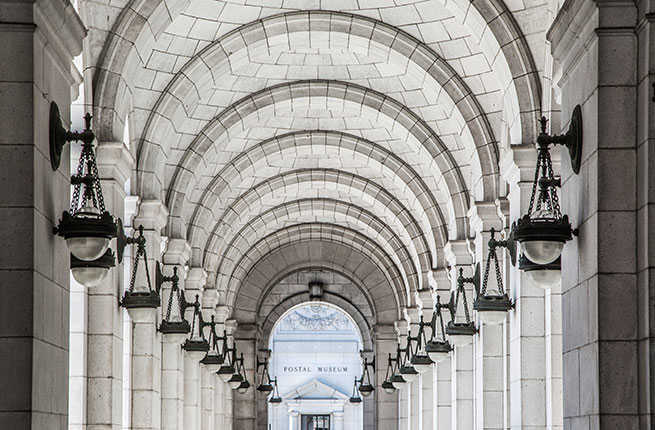
Washington D.C.
CAPITOL HILL MONUMENTS
START: Union Station
END: Eastern Market
TIMING: 1 hour if you skip the Capitol Tour
Washington, D.C., is a walking city, especially around the Mall, where America’s most famous monuments are clustered. Start at Union Station, a Beaux-Arts building modeled after a Roman bath; it dominates the northwest corner of Capitol Hill and is easily accessible on the Metro Red Line. Next door, the Smithsonian National Postal Museum will delight philatelists. Following Delaware Ave. south, you come right up to the massive U.S. Capitol, which sits majestically at the east end of the Mall. Tours leave from the Capitol Visitor Center, which is located underneath the building. In front of the Capitol, on the south side, is the United States Botanic Garden, the oldest botanic garden in North America. Walk east on Independence Ave., then north on 1st St., where the Jefferson Building of the Library of Congress and the U.S. Supreme Court sit side by side. The Library of Congress has so many books, recordings, maps, manuscripts, and photographs that it actually takes three buildings to get the job done. Inside the Jefferson Building, you can view the Great Hall, peek into the Main Reading Room, and wander through changing exhibitions related to the library’s holdings. Follow Pennsylvania Ave. south between 2nd and 6th streets. Take a break with the locals at any of the cozy restaurants, bars, and coffee shops that line this block. The Eastern Market on the corner of 7th and C streets is the perfect ending for this walk; it’s the city’s oldest market and a community fixture since 1873. Grab your picnic supplies here or a handmade keepsake from a local artist. The market is open from Tuesday to Sunday and really buzzes on weekends.
PLAN YOUR TRIP: Visit Fodor’s Washington, D.C. Guide


